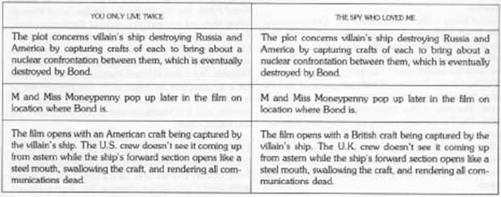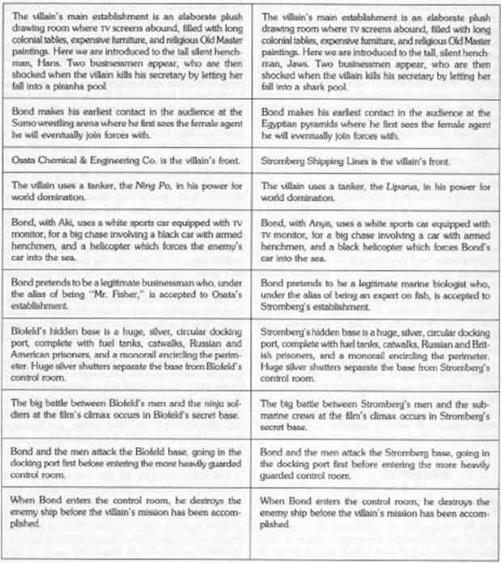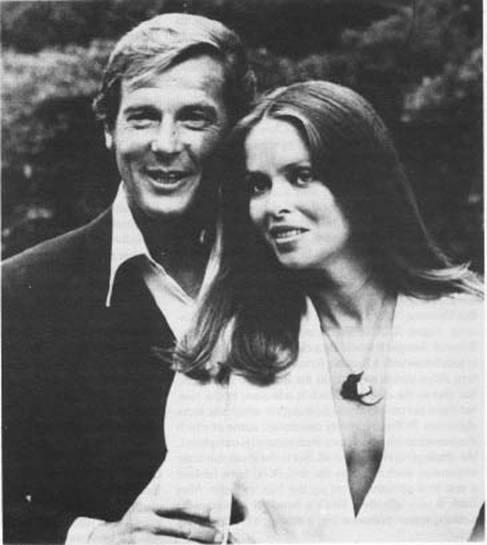The James Bond Bedside Companion (71 page)
Read The James Bond Bedside Companion Online
Authors: Raymond Benson

SCREENPLAY
T
he Spy Who Loved Me
is basically
You Only Live Twice
using submarines instead of space capsules. In an interesting article from
Bondage
magazine, Saul Fischer made a list of the similarities between the two films, totalling forty-six entries. A few of these similarities follow:

 (From "The Spy Who Lived Twice," by Saul Fischer,
(From "The Spy Who Lived Twice," by Saul Fischer,
Bondage
Number 7)
An interesting sidelight to all this is that when Cubby Broccoli was asked about the similarity between the two films at a public press conference held at the Museum of Modern Art in 1979, he replied that he didn't think the films were similar at all, and seemed confused that the question was even asked.
There is an attempt in the film to make the Bond character a little tougher, in contrast to Roger Moore's earlier approach. There are a few more fight scenes than in the two previous Moore efforts. But he still emerges from the battles basically unscratched. The fight with Jaws at the Egyptian ruins confirms Roger Moore's "brains before brawn" characterization of Bond. Jaws has accidentally knocked over a support beam while attempting to hit Bond, and the entire structure falls down on top of the giant. Bond walks away from the ordeal briskly wiping his hands, as if he had just swatted a fly.
The comic emphases are still present. Jaws, the new Oddjob, is a terrific character and might have been the best henchman of the series. But the script makes him absolutely indestructible; therefore, the character's increasing frustration at being outsmarted by Bond is intended to be funny. (It's like the notion behind the coyote character in the "Road Runner" cartoons.) Jaws is subjected to all kinds of punishment: electric shocks, toppling ruins, and the prospect of drowning in the ocean off the coast of Sardinia—but he seems always to come out unharmed. More on him later.
Christopher Wood supposedly added quite a few of these comic elements to the script. This theory is further supported by the fact that Wood alone wrote the screenplay to the most juvenile of the films,
Moonraker
.
Unlike the three previous Bond films,
The Spy Who Loved Me
at least holds together as a story. The set-piece formula, though executed with overindulgence, does not seem so obvious. There is a natural progression from location to location, and there are even some sections with genuine suspense. It is, without a doubt, the best Bond screenplay of the seventies.
DIRECTION
L
ewis Gilbert is back for his second Bond film. Significantly, he was the man who directed
You Only Live Twice
, the film that the new one so closely resembles. And like the previous film,
The Spy Who Loved Me
is full of big action scenes involving hundreds of extras and massive sets. Gilbert is a very good logistical director. His
mise en scène
captures the panorama of large picturizations with remarkable ease and control. The film moves with a brisk pace, never letting the audience catch its breath. But this speed hampers the picture in some ways. First, the plot information is communicated in extremely brief dialogue scenes, and the rest of the film consists of fast-moving set-pieces. Second, the comic elements of the movie tend to feed on the fast pace.
This is where Gilbert gets into trouble. He often allows the humor in the film to lapse into comic-book material. For instance, Bond is attempting to rescue Anya from Stromberg's establishment, Atlantis, before it is torpedoed by the
U.S.S. Wayne
. He comes upon the gargantuan Jaws, and a tense fight ensues. It looks as if it's going to recall the good old Oddjob days, as their grapplings take them into the room containing a shark pool. But the action then regresses into pure silliness when Bond maneuvers some kind of magnet attached to a line running above the pool over Jaws' head (what it's supposed to be used for is not explained). Bond gives a very Moore-ish grin at Jaws, causing the killer to smile. The magnet pulls Jaws up by his steel teeth. Unable to free himself, Jaws is then maneuvered by Bond over the shark pool. When he's in the right spot, Bond releases the magnet and runs to find Anya. Jaws falls into the shark pool. But he isn't eaten, of course. He eats the shark and climbs out of the pool!
There is also an embarrassing moment as Bond and Anya are walking across the desert after their van breaks down. The soundtrack plays the theme of
Lawrence of Arabia
. This is too cute. James Bond films should be anything but cute.
Gilbert also does not do much with the couple of good dramatic scenes the scriptwriters have provided. During the scene in which Anya discovers that it was Bond who killed her lover in Asgard, Roger Moore is surprisingly good and Barbara Bach is embarrassingly bad. Miss Bach is a competent actress, and has much presence throughout most of the film; but here, she is like cardboard. Gilbert could have shot more life into this flaccid, and important, scene.
The action passages, though, are very good. The final battle in the super tanker
Liparus
is quite a spectacle. Though it is entirely too reminiscent of the attack on Blofeld's volcano fortress (and Piz Gloria,
and
the oil rig in Baja), it is fun to watch. There is one good moment of suspense when Bond decides to extract a detonator from a nuclear missile and use it to blow their way into the fortified control room. After a few seconds of concentration and worry from the witnesses, Bond removes the device. He then rides atop a roving security camera attached to the ceiling across the area to the control booth window. He attaches the explosive to the wall, and the moving camera begins
its retreat. But the controls are switched off from inside so that the technicians may focus the camera on something. Bond is stuck ten feet away from the explosive. And he's at least fifty feet from the floor! After a moment of seat-clutching tension, the camera's belt is switched on again, and Bond makes it to a safe distance just as the detonator explodes.
There is one moment which seems out of place because of its violent realism. When Bond finally kills Karl Stromberg, the actor has been directed to convulse horribly for a second or two; and there is more blood than usual in a Bond film. There hasn't been a death this ugly since
Thunderball.
Gilbert seems to have a confused sense of directorial judgment. There are sequences that standout jarringly in the film. The humor undermines most of the suspense or tension in the story. What Gilbert has handled well is the overpowering spectacle of it all; and this is the picture's primary asset.
ACTORS AND CHARACTERS
R
oger Moore is his usual suave, sophisticated self, but there are moments when flashes of a tougher character come through. The filmmakers seem intent on emphasizing their belief that Moore is the ideal Bond ac
cording to Fleming's picture of the character. At one point in the film. Bond visits a sheikh named Hussain. Hussain was an Etonian classmate of Bond's, and they refer to this in their conversation. But the "real" Bond would be disinclined to talk about his days at Eton, since his attitude toward his school tie is very cynical, so the filmmakers are distorting Bond's character with this ploy.

Roger Moore's leading
lady
in
The Spy Who Loved Me
was lovely Barbara Bach as Russian agent Anya Amasova. (Wide World Photo.)
Moore is better in the fight sequences, though. There is one terrific fight on a rooftop with Sandor, one of Stromberg's henchmen. At one point in the battle, Sandor almost falls off the roof backwards, but saves himself by grabbing hold of Bond's tie. All Bond has to do is knock Sandor's hand away and the man will fall to his death. Bond asks where he can find Fekkesh, a man in possession of a microfilm containing plans of Stromberg's submarine tracker. Sandor, fearing for his life, answers Bond quickly. And then, Moore calmly chops the man's hand and Sandor falls. This is more like something the Sean Connery Bond would have done—it's somewhat out of character for the Roger Moore Bond. It's a moment that stands out.
There's another interesting instance when Bond first speaks with Anya at the Mojave Club. She seems to know all about him, and begins to relate his past and biographical facts to his face. Bond is slightly amused until she begins talking about his marriage. Immediately, we see Bond stiffen, and a dark cloud passes over his face. He cuts her off and abruptly rises from his seat. This is the first reference to Tracy since
On Her Majesty's Secret Service
. Moments like this tend to make Bond a little more human, and they are a pleasure to see. Moore is quite effective here.
Barbara Bach, an extremely attractive actress and model, portrays the "Me" of
The Spy Who Loved Me
. But Vivienne Michel she isn't. She is Major Anya Amasoya, Agent XXX of the Soviet Union. Apparently, Broccoli thought it would be a classic situation for Bond to join forces with a Russian female counterpart. Therefore, Anya serves not only as the Bond-girl in the film, but also as the ally. Miss Bach is adequate in the role, but there are certain dramatic scenes in which she lacks dynamics. In the previously mentioned scene in which she swears to kill Bond once their mission is completed, she displays no emotion at all. But in the more romantic sequences, such as when she and Bond have hitched a ride in a peasant's boat up the Nile to Cairo, Miss Bach is very effective. She's a beautiful woman with a strong screen presence that is missing in some Bond-girls.
The late veteran German actor Curt Jurgens portrays Karl Stromberg, and his performance is disappointing. Stromberg is a man in love with the sea, hoping to build a new city of followers in Atlantis, his underwater fortress. He is attempting to destroy life on land to make this possible. It's obvious that Stromberg was Blofeld in an early script, because his mannerisms, speech, and environment all reflect that character. The only thing missing is the white cat. Jurgens is a fine actor, but he plays the role on one level. He speaks slowly, and there is no energy in his delivery. To put it bluntly, Karl Stromberg is a dull villain. We've heard and seen it all before.
More interesting, however, is his super-henchman, Jaws. Played by the over-seven-foot-tall Richard Kiel, this character was an immediate hit with younger audiences. The response to the character was so great that the producers decided to bring Jaws back in the next film, Moonraker. An indestructible giant of a man, equipped with sharp, steel teeth, Jaws disposes of his victims by biting them in the neck, Dracula-style. Jaws has no dialogue, but he makes his intentions known through facial expression. The character is fun and proves to be quite menacing in certain sections. But the filmmakers insist on using the character for comic effect. The situation would worsen in
Moonraker
. Kiel, however, performs his role with vigor and conviction.
